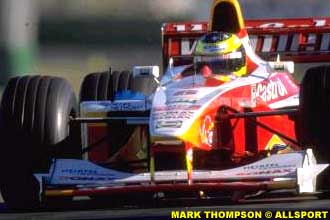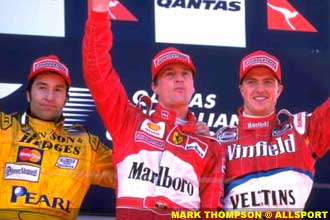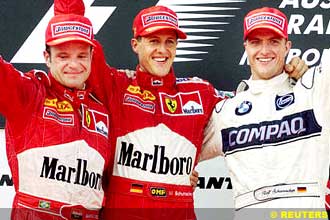| ATLAS F1 Volume 7, Issue 9 | |||
 |
Focus: Ralf Schumacher at Albert Park | ||
| by Marcel Schot, Netherlands | |||
|
Prior to every race, Marcel Schot will focus on one driver, one track: the relationship between the human being and tarmac. This week, we reviews Ralf Schumacher's past at Melbourne - from his debut in 1997 with Jordan to his recent successes with Williams
Ralf Schumacher's performance at Albert Park has had two very different faces in the past. In his first two years with Jordan, things went pretty disastrous, while on the other hand his last two years with Williams were very successful.
In the first free practice Schumacher did make a good impression. In his very first official Formula One session, the German put his Jordan in a very good fifth spot. Both he and his teammate Giancarlo Fisichella used the Friday practice for merely getting comfortable with the circuit, rather than trying to put in the fastest possible time. Judging from his performance, Ralf felt comfortable right away. Schumacher himself appeared very satisfied, only commenting that the track was very dirty.
The second free practice session, on Saturday morning, confirmed Schumacher's complaint. With the track cleaned up by the cars on Friday, times were a lot quicker the next day. Schumacher dropped back to seventh place, but this was barely a surprise since both McLarens were the ones to pass him. Meanwhile, Ralf was a full second quicker than his more experienced teammate.
On race day, things got better for the young German, when we outperformed his famous brother in the warm-up. However, once the actual race started, things went the other way again. After having made a great start, which brought him right up to eight place, the bad qualifying had been overcome within minutes. However, just as many minutes later, it was all over for Schumacher. In his debut race, the gearbox failed completely after just two laps.
The next year, Ralf Schumacher was no longer a rookie. With 13 points and a podium finish in Argentina, young Schumacher showed he had potential. With that in mind, his return to Melbourne was expected to give a more satisfying result than the year before.
As the Albert Park circuit features very few of those, it came as no surprise that Schumacher and Hill weren't able to make a major impact in qualifying. Schumacher was able to outqualify his teammate, but only with the smallest of margins: seven thousands of a second separate the two buzzing hornets. Schumacher had to start the race from ninth place, while Hill was tenth.
Just like the year before, the warm-up showed the best of Ralf Schumacher. The young Jordan driver only had his brother's Ferrari and both McLarens ahead of him, while his teammate came even closer than in qualifying - now just three thousands behind. And again, the warm-up was where the good things ended.
After a disastrous start, Schumacher dropped back from ninth to 14th in the first lap. After a short trip through the grass, he came back onto the track just ahead of Stewart driver Jan Magnussen. The Dane, in an attempt to outmaneuver Schumacher, then hit him.
Unlike previous years, free practice didn't go very smoothly for Schumacher. On Friday he ended up in tenth place, just behind his teammate, while on Saturday things got worse and Schumacher dropped back to 15th. Despite all this, Ralf wasn't concerned yet, as the team had just concentrated on the race setup. The new Williams driver commented: "Based on the way we performed today, we are confident that we will be able to qualify reasonably well."
Reasonably well was indeed the correct prediction. After an intense hour on Saturday afternoon, he found himself in eighth position, well ahead of Zanardi. Warm-up showed Schumacher in the same position and thus came the race.
After thirteen laps, Schumacher found himself yet another spot higher in the order. McLaren's David Coulthard suffered the same fate as Schumacher had had two years ago: his gearbox failed. In the next lap, Canadian Jacques Villeneuve crashed, after which the safety car had to come on track. Once the safety car left the track again, a problem with Mika Hakkinen's accelerator caused a rather chaotic restart. While Hakkinen dropped back to the back of the field, Jarno Trulli surprised Schumacher and took over third place.
Just a few laps later, the second CART champion also crashed. Schumacher's teammate Zanardi lost the back of his car and crashed out rather hard, causing a second safety car situation. As Jarno Trulli made a pitstop during the safety car situation, Schumacher now climbed into third. Which was the position where the German found himself once the pitstops were done. He then showed the experience he gained in his first two seasons by staying calm and securing the podium finish, just seven seconds behind first time winner Eddie Irvine.
Initially, the downward spiral continued, when Schumacher had quite a bad start, which dropped him back to 13th place. After six laps, the tide started to finally turn again. Pedro de la Rosa's Arrows crashed out, taking Eddie Irvine's Jaguar along. De la Rosa's teammate Jos Verstappen also retired. Later it became clear that both Arrows suffered a suspension failure within seconds. To clear up the debris, the safety car was deployed. Schumacher, in tenth under the safety car, then got another free position improvement, when David Coulthard's engine went up in smoke.
This year, the Australian Grand Prix will be the fifth for Ralf Schumacher. Will he continue his upward spiral down under? Could he take one step up on the podium? With just a few days away, that remains to be seen.
|
| Marcel Schot | © 2007 autosport.com |
| Send comments to: schot@atlasf1.com | Terms & Conditions |






